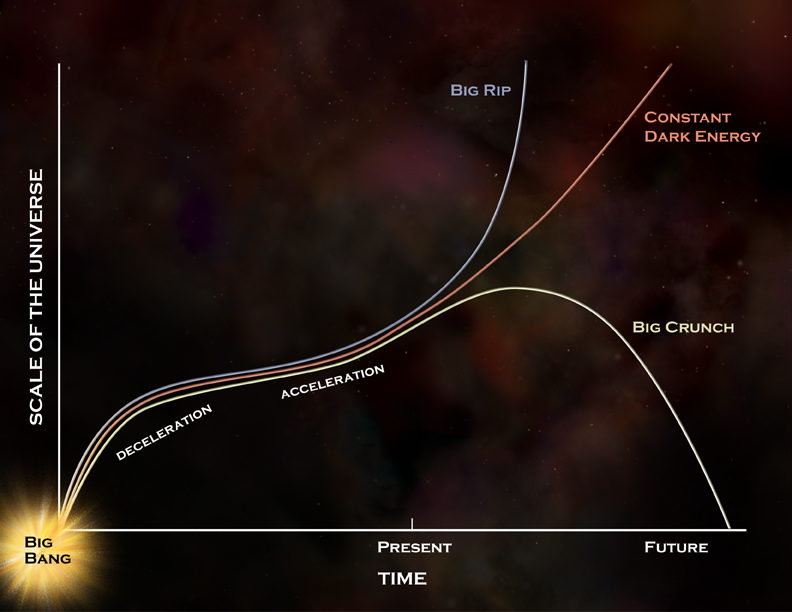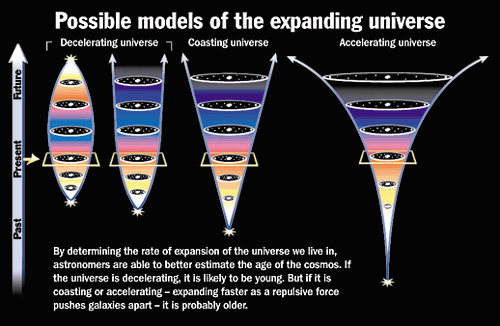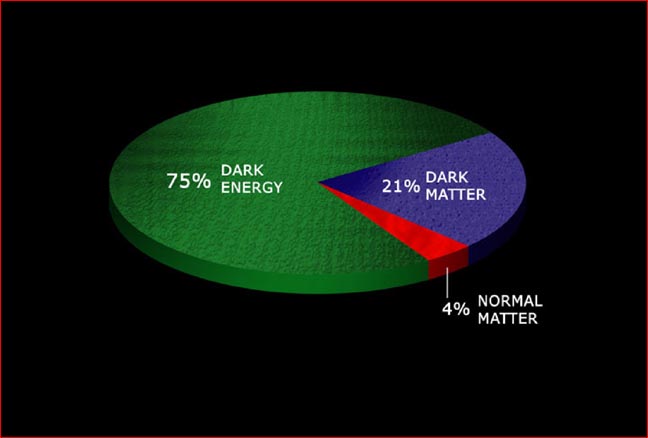1) Perception: Nobel Prize for Einstein’s Greatest Blunder
The last Nobel Prize in physics went to Saul Perlmutter, Adam Riessand Brian P. Schmidt, all having been vital in the discovery of that the universe’s expansion is speeding up; research that was done during the 1990s.

Saul Perlmutter receiving the Shaw Prize for astronomy in 2006 with Brian Schmidt and Adam Riess.
With this Nobel Prize, dark energy, aka the cosmological constant, aka Einstein’s greatest blunder, aka the accelerating expansion of the universe, has gotten its deserved recognition: The accelerated expansion of the universe (and thus dark energy) is proper science, period.

Two independent teams - the High-Z Supernova Search Team (headed by Riess) and the Supernova Cosmology Project (Perlmuter) - found that a group of star explosions called Type Ia supernovae were dimmer and therefore farther from Earth than expected. The light from more than 50 distant stars that went supernova was investigated and turned out far weaker and red-shifted than expected from gravity theory after Einstein tossed the cosmological constant out.

Perlmutter, Adam Riess, and Brian P. Schmidt being awarded the 2006 Shaw Prize in Astronomy.
Einstein applied Occam’s (Ockham’s) razor: given two equally powerful theories, the more parsimonious one, i.e. the one with less assumptions, should be favored. If aspects are hidden, like for example preferred reference frames in relativity, they could be unnecessary assumptions. Occam’s razor is a popular argument and relates to for example Leibniz equivalence, the parsimony of identifying indiscernible states. Occam’s razor is also one of the most misapplied ideas around, considering the ever improving ability to discern previously hidden or ‘unnecessary’ aspects.

The discovery of accelerated expansion was unexpected and the researchers thought for a long time that the finding must be a mistake. They were basically just trying to find something wrong with their measurement. Perlmutter, Schmidt and Riess were trying for a long while to make the accelerated expansion disappear, but the more they analyzed the data, the surer they became that the universe will expand ever faster, taking all galaxies away from each other, leaving a totally dark and cold sky.
Nevertheless, dark energy is still widely rejected by way too many people who should know better. The main reason for dark stuff being rejected is perhaps psychological: “Dark” scares day-time hunting animals like us. People do not care much about the “cosmological constant”, which is dark energy if constant over time. With “dark matter”, the “dark” merely implies that the matter is not as visible as that inside blindingly bright stars that shine in skies gazillions of light years away. Cold brown dwarf stars and other entirely mundane things belong to dark matter, too. With dark energy it is similar as that the “dark” simply means that there is nothing (directly) visible about it, which is very usual for all kinds of energies; in fact, one cannot see any energy as such.

A bigger problem with the acceptance of dark energy and dark matter among the more educated is that they are too often presented as if they are twins, as if introducing a line of cheap ad hoc fudge factors: Dark energy, dark matter, dark force, what next? However, even if all others are, dark energy is not a fudge factor and not new. I will get back to this in section 3.
The biggest problem with dark energy for many who know a lot about physics is the crazy way it tries to pull itself together (its negative pressure) counterintuitively leading to becoming ever bigger:
2) Dark Energy: The Ultimate Sisyphus
Dark energy is really crazy. However, the crazy part is not actually the problem of dark energy but one of basic general relativity. Many educated people are proudly critical of dark stuff, but when it comes to general relativity, they do not want to be found hanging out in the crack-pot corner. They especially should bear with me here.
Some comments on the space plunger and on energy non-conservation illustrated the big difficulty. I will let Straw-man give his version:
Straw-man: “Imagine a box with gas having the pressure P that pushes on the walls of a box. Now add gravity: Either make the gas molecules heavier, or add a big mass in the middle of the box. This “added” gravity will pull the particles towards each other, and it pulls on the walls, and these two each imply that the added gravity is a negative contribution to the pressure. Thus, gravity is negative pressure; it pulls. Pressure is the opposite of gravity: repulsion, not attraction! However, dark energy increases with volume and thus has negative pressure. It should contract, yet leads to expansion of space!?!”
All this is correct up until “the added gravity is a negative contribution to the pressure”. Gravity may pull on the walls, but that pull is proportional to the mass of the walls. Gravity also pulls on the gas particles, thus they are more numerous in the center of the box, but that may even increase the pressure: although the particles collide less often with the walls of the box, they collide more often with each other in the center of the box. If the mass is so large that all the gas is clumped into a hot sun in the center of the box, the walls feel little pressure. The pressure in the box is nevertheless large, because the pressure in the sun is large. With gravity, pressure becomes inhomogeneous, and all the pressure of a system, just like all the energy, contributes to the total system.
There are no negative pressures in Straw-man’s box of gas. Gravity is not pressure. In Einstein’s equation Guv + Λ guv = Tuv, pressure is in the pressure-energy density tensor T on the right hand side. It is the physical source of what happens. Gravity, the Guv, is on the left side. Its essence is curvature of space-time. Gravity is non-linear, meaning gravity self-interacts and it is thus somewhat also ‘its own source’. Still, G is curvature of space-time, not a force; T is what includes pressure as a source.
Straw-man: “Dark energy has negative pressure. So how can it lead to expanding space? Internal pressure expands stuff! Internal negative pressure contracts.”
Dark energy is not expanding stuff. Space itself expands. Dark energy has negative pressure. It wants to contract. It tries to pull itself together. However, because its pressure is more negative than its energy density contributes positively, space-time is curved in such a way that space expands. So there is more and more space, and thus there is more and more dark energy, too. Dark energy is the ultimate Sisyphus. It is shy; it wants to disappear into a point, but trying to do so, space-time blows it up onto a bigger and bigger stage. Pure Buddhism: The very act of trying to relieve suffering creates it.
The crazy point is that something that pulls itself together, expands, but that is usual general relativity as accepted for almosta century by now: Pressure, although it pushes and "wants to expand", contributesto gravity, which pulls and leads to contraction. For example, it is the contribution of the internal pressure that makes a neutron star collapse to a black hole. If you do not accept that, why blame today’s researchers? Have the guts to doubt Einstein.
3) Dark Energy, with us already for a Century
Take a usual pendulum, like a massive bob hanging from a string, and watch it swing. Write down the equation that describes this pendulum: It has mass M and the length of the string L and also a term for the gravity of the earth. You can see how simple these formulas are at Wiki's Harmonic Oscillator. Now say that the swinging slows down. There is a damping term D in the equation that describes that. Now somebody opens the window. Wind turbulences around the pendulum accelerate it slightly; you see the pendulum swinging more again although you do not even feel the wind. Mysterious?

Of course not. And the equation that describes this is easily modified: Add an applied force term F(t). These terms in the equation of the harmonic oscillator, the damping D and the driving F(t), are completely natural and expected. Given another pendulum, for instance a mass hanging from a spring, you apply a very similar formula.

If we enter observations of the oscillation, the formula will tell us whether there is damping going on: the damping D turns out to be non-zero. It also tells us whether there is a driving force that feeds the oscillation, namely if F(t) is non-zero.
You would be a fool to look at the data of a pendulum and start to reject physics just because the observations tell you that F(t) is non-zero. You might not yet know what exactly is driving the system, the wind or a magnet or whatever, but something pushes it.
Dark energy comes from the classical theory of relativity known for a century now. Here is once more Einstein’s equation Guv + Λ guv = Tuv with the pressure-energy density tensor T on the right hand side and gravity, the Guv, on the left. You have this usual equation and you look at a particular system to which the equation is applicable, the universe, and enter observational data, here from the observed expansion of space. There is a driving term Λ (lambda) in there. Lambda was not put in there by hand much later. It should be in there, just like there should be a damping D and a driving F(t) if you want to describe some oscillator that you come across. Observation tells us that Λ is non-zero, in fact it is about 10-10 Joule per cubic meter. This is generally called dark energy or, if it is constant over time, cosmological constant.
Does dark energy exist? Does the driving term in the formula of the harmonic oscillator exist? It is right there on the paper where I wrote it down, and in that sense it would even exist if it turned out to be zero.
You may ask what the fundamental nature of dark energy is: Is it quantum vacuum energy? There are many unknowns, but it is not valid to say that dark energy does not exist or has not been observed. It is the observed data that leave the dark energy term non-zero. And that is dark energy – the lambda term does have the units of energy – just like the pressure-energy density tensor T (g has no units).
Some do not "believe" in dark energy. Imagine I measure the damping term D of a pendulum to be non-zero and then people blabber about that "friction" cannot possibly be because what on earth is "friction" supposed to be.
Everybody who throws dark energy and dark matter into one pot is highly suspect. Dark matter can be called a hypothesis, a good one by the way, although dark matter does not fit well to galaxy rotation curves – Modified Newtonian Dynamics (MOND) fits better (See: Begeman, Broeils,&Sanders 1991; Sellwood&McGaugh 2005). The driving term F in the formula describing an oscillator is not a hypothesis.





Comments